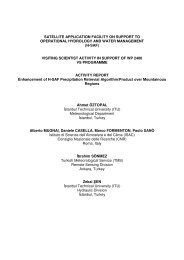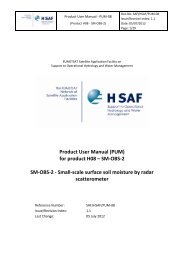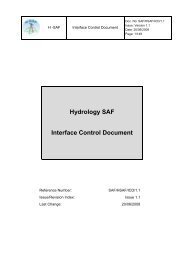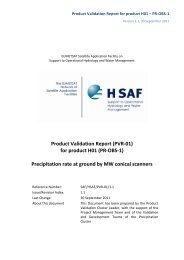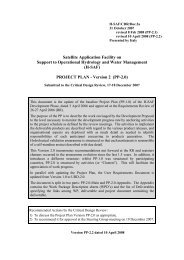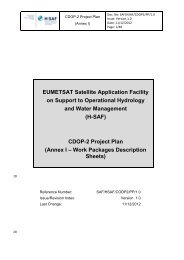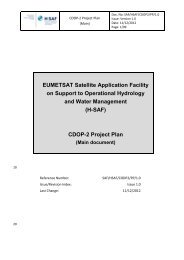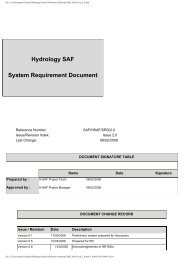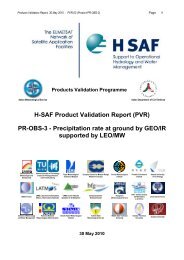Zuhal Akyurek, A. Unal Sorman - H-SAF
Zuhal Akyurek, A. Unal Sorman - H-SAF
Zuhal Akyurek, A. Unal Sorman - H-SAF
You also want an ePaper? Increase the reach of your titles
YUMPU automatically turns print PDFs into web optimized ePapers that Google loves.
Another disadvantage of passive microwave imagery is its limited capability to penetrate<br />
wet snow cover.<br />
Development of snow cover products based on multi-sensor data sources have been<br />
performed recently, because of the need for continuous regional and global snow cover<br />
mapping for climate, hydrological and weather applications. Romanov et al. (2000)<br />
proposed a system using a combination of observations in the visible, mid-infrared, and<br />
infrared made by the Imager instrument aboard Geostationary Operational Environmental<br />
Satellites (GOES) and microwave observations of the Special Sensor Microwave Imager<br />
(SSM/I) aboard the polar-orbiting Defense Meteorological Satellite Program platform. The<br />
devised technique was applied to satellite data for mapping snow cover for the North<br />
American continent during the winter season of 1998/99. In their study snow identification<br />
with the combination of GOES and SSM/I observations was found to be more efficient than<br />
the one based solely on satellite microwave data. Kongoli et al. (2006) blended Advanced<br />
Microwave Sounding Unit (AMSU) and Interactive Multi-Sensor Snow and Ice Mapping<br />
System (IMS) data to map snow cover and extent.<br />
A preliminary blended-snow product has been developed jointly by the U.S. Air Force<br />
Weather Agency (AFWA) and the Hydrospheric and Biospheric Sciences Laboratory<br />
(HBSL) at NASA / Goddard Space Flight Center. A description of the preliminary product,<br />
called the AFWA – NASA or ANSA blended snow-cover product is given in Foster et al.<br />
(2008a). The prototype product utilizes the Moderate-Resolution Imaging<br />
Spectroradiometer (MODIS) standard daily global (5-km resolution) snow-cover product<br />
(Hall and Riggs, 2007) and the Advanced Microwave Scanning Radiometer for EOS<br />
(AMSR-E) standard daily global (25 km resolution) snow-water equivalent (SWE) product<br />
(Kelly et al., 2003) to map snow cover and SWE. Preliminary evaluation of the ANSA<br />
blended snow product was performed in several studies. Hall et al. (2007) performed the<br />
validation of the blended snow cover product over the Lower Great Lakes region. They<br />
indicated the use of the new product improve the mapping of snow cover compared to<br />
using either the MODIS or AMSR-E product, alone. Casey et al. (2008) evaluated the new<br />
product in Finland for the 2006-2007 snow season using 9 ground observations.<br />
“Satellite Application Facility” on Support to Operational Hydrology and Water<br />
Management (H-<strong>SAF</strong>) is established with an aim of generating satellite-derived products<br />
specifically designed as to comply with requirements for operational hydrology and water<br />
management. The main objectives of H-<strong>SAF</strong> are to provide new satellite-derived products<br />
from existing and future satellites with sufficient temporal and spatial resolution to satisfy<br />
the needs of operational hydrology and to perform independent validation of the usefulness<br />
of the products on hydrological applications. So far the snow recognition (SN_OBS1), and<br />
snow cover (SN_OBS3) products retrieved from satellite data for the mountainous areas<br />
within the H<strong>SAF</strong> domain were put in the processing chain. The snow water equivalent<br />
(SN_OBS4) product will be available in the mid of 2009. During the improvement and<br />
tuning of the snow retrieval algorithms, the intensive validation studies will be<br />
implemented. The combination of snow cover products obtained from optic and microwave<br />
data can provide continuous regional and global snow cover maps.<br />
5




